#manchurian incident
Photo
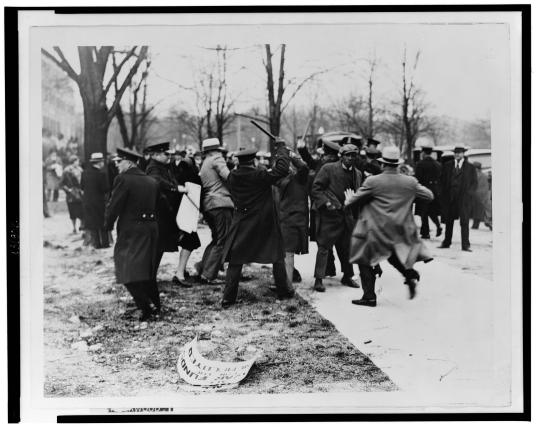
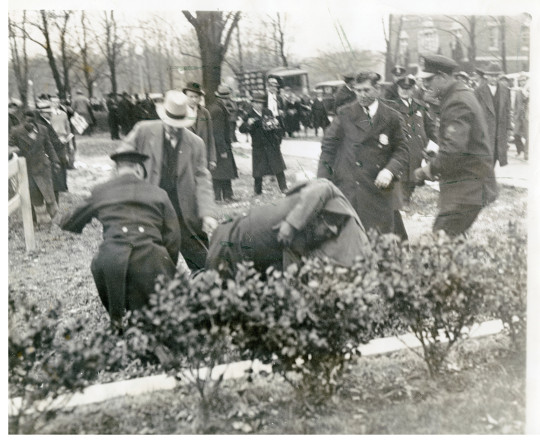
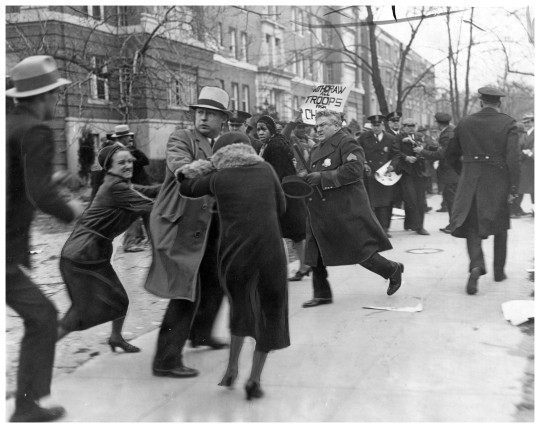

Police break up anti-imperialist protest, Washington DC: 1932
A protest took place near the Japanese Embassy at 2514 Massachusetts Ave. NW in Washington, D.C..
Police attacked the 30 demonstrators with clubs, fists and blackjacks while staff at the Japanese chancery watched from the roof and windows.
The protestors resisted and knocked down several of the police, including one who was hospitalized as a result of the confrontation. One of the demonstrators, Joan Hardy, was knocked unconscious during the fight.
When International Labor Defense attorney Bernard Ades went to seek their release at the Third Precinct station, Superintendent of the Police Pelham Glassford expelled him from the station.
Glassford had ordered the arrest of the demonstrators for parading without a permit, even though they were on the sidewalk and not blocking traffic. Some of the demonstrators were also charged with assault.
The Japanese army invaded Manchuria on the mainland in November 1931. Chinese forces resisted until February of 1932 when they were defeated. Guerilla warfare continued until the end of World War II in 1945. Reports and photos of Japanese bombing of civilians and shooting of unarmed survivors caused revulsion around the world at the expansion of the Japanese empire.
The Japanese invasion of Manchuria is regarded as the opening salvo in what became World War II.
1) Police break up a peaceful demonstration protesting Japanese army atrocities in Manchuria near the Japanese Embassy at 2514 Massachusetts Ave. NW in Washington, D.C. on March 26, 1932.
2) A police officer wrestles a demonstrator to the ground March 26, 1932 while breaking up a peaceful demonstration protesting Japanese army atrocities in Manchuria.
3) Two women fight back as police break up a peaceful demonstration protesting Japanese army atrocities in Manchuria near the Japanese Embassy at 2514 Massachusetts Ave. NW in Washington, D.C. on March 26, 1932.A sign can be seen reading “Withdraw All Troops from China.”
4) Two of twenty demonstrators arrested by police are awaiting “black marias” (paddy wagons) after a fight with police who broke up a peaceful demonstration protesting Japanese army atrocities in Manchuria near the Japanese Embassy at 2514 Massachusetts Ave. NW in Washington, D.C. on March 26, 1932.
Source.
#washington dc#anti-militarism#anti-imperialism#protest march#political protest#sino-japanese war#january 28 incident#invasion of manchuria#manchurian incident#communist party of the united states#police brutality#police violence#the great depression#history of crime and punishment
11 notes
·
View notes
Text
What Movie Would You Like to See a Quality Updated Remake of?
Please suggest more if you have them.
48 notes
·
View notes
Link
The first step to be on the other side by remembering the day, Sep. 18th.
It might help to have a different view and wider view.
0 notes
Text
Mr. Smith Goes to Washington: Genre and Themes
At first glance, indeed, even at second glance, Mr. Smith Goes to Washington doesn’t seem to really lend itself to a specific genre the way The Goonies or The Princess Bride did. Whereas those films positively dripped with the atmosphere of an adventure or fantasy film, Mr. Smith Goes to Washington is considerably more ‘real world’ than that, without necessarily heading into ‘slice of life’ territory.
If story is the backbone of a film, the underlying solid base, then genre is the trappings, the flavor, the seasonings the writers get to play with to create their final dish. Some stories automatically come with pre-packaged genre, as it would seem, stories like Frankenstein seem little suited to be anything other than a sci-fi horror film, after all, but most, and indeed some would say all stories have the capabilities of remaining solid in their identities, even with a completely different genre than we’re used to.
In the case of Mr. Smith Goes to Washington, however, there doesn’t seem like there’s a lot of ingredients to mix.

Officially, Mr. Smith Goes to Washington is labeled as a ‘political comedy-drama’, an eclectic mishmash of styles that doesn’t necessarily rear its head too often in the realm of film. Political films tend to be more true stories like All the President’s Men, or thrillers like The Manchurian Candidate. Mr. Smith Goes to Washington is neither. However, that isn’t to say it’s not political.
The entire world of Mr. Smith Goes to Washington is politics. It lives and breathes the inner workings of American bureaucracy, without either exploiting or sugarcoating it.
It is, at its core, an anti-politics political film. There is no pleasure that the film derives from exposing any corruption, nor does it take pains to pretend that corruption does not exist. It freely paints the politicians and the non-politicians as people, dealing with consequences to their actions: from Senator Paine, the tarnished hero, to Clarissa Saunders, the cynical, worn-out tool of Washington. The focus of the story is not so much on the inner workings of the state and country as it is the people that perform them, that manipulate the cogs of the machine to their own benefit, and those who stand to prevent it.
It’s not a very technical film. You don’t have to have a degree in law in order to understand the film, or allow it to resonate, and that, perhaps, is what makes it so special.
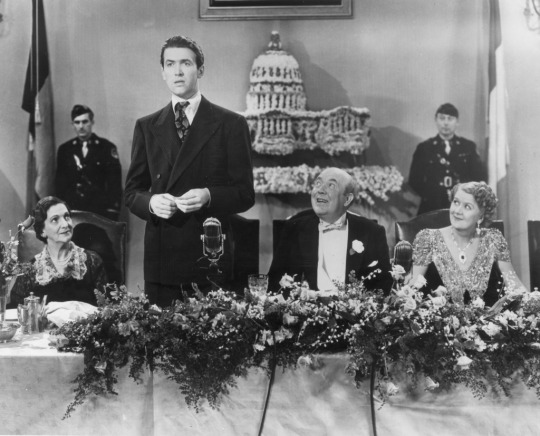
The ‘political’ slant of Mr. Smith Goes to Washington isn’t in the process that Saunders outlines to Jefferson in order to get his bill passed. On the contrary, the bill itself is a minor incident, the catalyst that forces the corruption out into the open. The story isn’t about the bill at all, nor is it even about the plot of the other politicians: it is about the politicians themselves. There are no parties mentioned, no real figures portrayed, no accurate historical events referenced: and yet something about this film did strike a chord in the very real Washington D.C.
Upon Mr. Smith’s release in Constitution Hall, DC dissolved into uproar about the film’s portrayal of American politics, to the point that Alben W. Barkley, the Senate Majority Leader at the time, remarked that it: “makes the Senate look like a bunch of crooks”.
In other words, something about this film struck some people, mostly the people in Washington, the wrong way. And yet, even at the time of its initial release, audiences, the Mr. Smiths of the USA, adored it for a reason.
At its core, chiefly, yes, Mr. Smith is a film about politics, and even history. Every fiber of the movie vibrates with patriotism, with love for America, and with pride in democracy. The film is not a condemnation as such as it is a warning: ‘we will lose what we have built if we think only of ourselves.’ It is a perfect combination of both a celebration of America’s past, and a concern for the future, a notation of the path the nation’s leaders seemed to be going down. Mr. Smith Goes to Washington is a story about big P Politics, all right, but it is not a scowling, scolding film, pointing an accusatory finger at the little p politicians, the fallen white knights. It is instead a film that holds up a figure of a person who knows on what the country was founded, and believes in it so strongly enough that he forces a change, even if it’s a small one.

And the film is also pretty funny, too.
The genre of ‘comedy’ tends to bring to mind slapstick or wordplay classics, and in the 1930s, the ‘comedians’ definitely had their specific brands: the Marx Brothers, the Three Stooges, Laurel and Hardy, and others were taking cinema by storm. Audiences, especially in the middle of the Great Depression, desperately wanted a laugh, and even though there were no pratfalls in Mr. Smith Goes to Washington, there is a wry sense of humor about it, particularly near the beginning.
Early scenes in this film play almost like scenes from a ‘fish out of water’ comedy, with Jefferson Smith having no idea how to function in the new, fast-moving, cynical climate of Washington D.C. Other characters, such as Saunders and Diz, exist as quip-generating machines, full of the fast-paced, witty dialogue characteristic of films of the time. Many of the more comedic sequences in the story come about through direct conversation between Saunders and Smith and the subsequent clash of ideas and personalities.
So yeah, Mr. Smith is a pretty funny movie at times. I must admit though, it’s hard to make the argument that it’s a comedy.

Smith’s plight is not comedic, at least, not more than halfway through the story. He is not a comedic figure, nor are most of the characters around him. While one could make the argument that the initial conceit of the story is comedic, I am hard pressed to agree that the story remains a comedy throughout. If anything, the throughline of tragedy seems clearer, notably in the character of Senator Paine.
Paine is what Smith could have been: a noble figure broken by greed, by corruption, by fear, turned into another cog in someone else’s profit machine, willing to throw countless people under the bus for gain. By the end of the story, he is not only guilty, he is convicted, ashamed after being forced to confront what he has become. His story nearly ends in suicide, and it certainly ends in the ruination of his career, after having thrown away belief in all of the words he is so used to spouting. He is the warning thrust up before contemporary Washington’s eyes: the white knight tarnished by greed.
Smith’s story, though uncorrupted, is similarly bleak: unbelieved, unheard, and unable to get the word out, he ends the film exhausted and crushed after hours of seeming futility. The film’s happy ending does not come as a result of all of his hard work, but through the guilt of Senator Paine driving him to confess. Smith does not reach the climax of the film like a comedy protagonist does at all, but like a tragic hero.
And yet, this film isn’t a tragedy either.
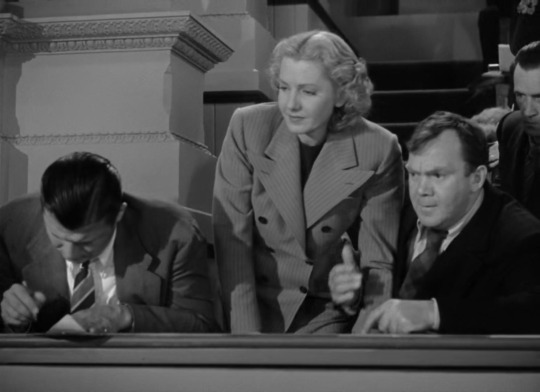
So what is it?
I have a theory: that a film’s genre can be best solidified through a few major checkpoints: its themes, and its characters, specifically its protagonist.
The themes of Mr. Smith are obvious ones: duty to one’s country, certainly, but honesty above all. The liars are the villains, and the heroes tell the truth. The story is built around good morals and simplicity, with the center of virtue being Mr. Smith himself.
In another era, Smith himself may have been a knight in shining armor, risen to his position from peasantry to achieve noble deeds. As it is, in 1930s America, Smith is an ordinary man in an extraordinary position: an everyday guy elevated to the position of senator.
Of course, the intention was never to give him any real power, but nonetheless, power he wields. And it’s his decisions on handling that power that set him apart from the other characters. He behaves very much like a normal person, an average citizen in a political jungle with very little navigation. There is no hero’s journey here: if anything, Mr. Smith finishes the story as a broken, more cynical character rather than a triumphant hero. The victory is in refusing to compromise your principles, no matter the cost or circumstance, and there is no dragon to slay here: just men, corrupted by power.
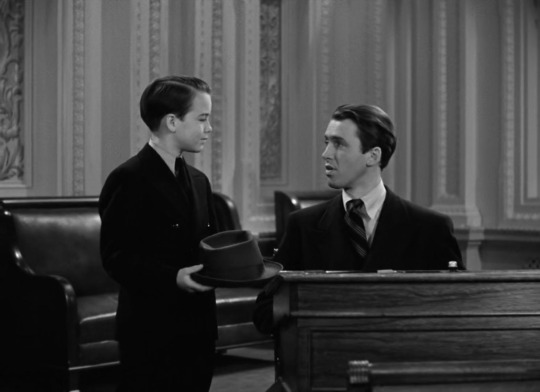
In other words, it’s a drama.
While there are many forms of ‘drama’ in the broad spectrum, typically, the term ‘drama’ means that a subject is more dramatic than humorous, with a primary element of the story being conflict, but not necessarily of the physical kind. It’s a story with more of an emphasis on who the story is happening to, and why, with less concern for what exactly is happening.
Such is the case for Mr. Smith Goes to Washington.
Mr. Smith is a story about real people, people you or I might know, from the virtuous Jefferson Smith to the cynical Ms. Saunders, to the corrupt, but still human, politicians, some malicious, some merely led astray from their previous values. This is not a story of ‘heroes vs. villains’, this is a story about the ‘Right Thing to Do’, and the people with the courage to do it.
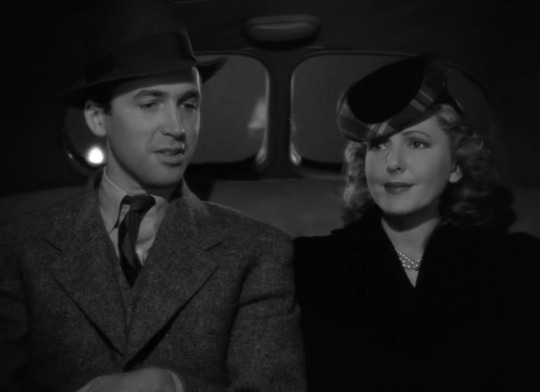
And that’s most of its appeal.
Capra’s passion is for people in this film, the everyday, the ordinary, the ‘Little Guy’ who becomes, not a dragonslayer, but a man with the opportunity to truly do some good, faced with tough decisions. It’s a story full of heart, sprinkled with humor, and loaded with humanity as it views, through very human lenses, the world of politics through a protagonist who’s meant to be a fish out of water.
That is Mr. Smith’s legacy.
The story isn’t groundbreaking. The cinematography isn’t breathtaking. The writing isn’t jaw-dropping. But the people, the characters, live and breathe on the screen as people, characters that the audiences love, and cheer for. We root for these people because of the drama of the situation, and the time and care that the film takes to delve into them.
That, more than the politics of the situation, is the reason people return to this film again and again.
And that, the people, the characters, is what we’ll be turning our attention to next time.
#Mr. Smith Goes to Washington#Mr. Smith Goes To Washington 1939#1939#30s#Film#Movies#Political#Drama#Comedy#James Stewart#Jean Arthur#Claude Rains#Edward Arnold#Thomas Mitchell#Frank Capra
25 notes
·
View notes
Text
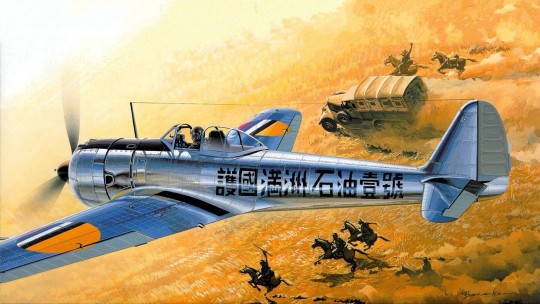
1945 01 Nakajima Ki-43-II Ko I Hayabusa Manchukuo - box art Finemolds
‘From Manchurian Oil Company No. 1’
Documentation and footage found by experts indicates that the Manchukuo Imperial Air Force’s Ki-43 Squadron flew the Ki-43 II. Version II was a significant improvement over the Ki-43 I thanks to its 1150hp Nakajima Ha-115 engine, redesigned fuselage of the main wing and a three-bladed propeller. The tremendous increase in power output of the Nakajima engine was achieved by upgrading the Ha-25 powerplant with a two-stage supercharger. This modification helped to improve the top and cruise speed of the aircraft to 536 km/h and 355 km/h while allowing it’s operational range to stay at an acceptable level of 1610 km without drop tanks. The Manchukuo Imperial Air Force’s Hayabusa squadron was pictured in ‘Manchukuo War Chronicles #283,’ dated 12 December 1944. From this, we learn that the squadron operated from the Fengtian Air Base and consisted of 4 aircraft that had been donated by Manchukuo citizens and the Manchurian Oil Company. Each aircraft carried the name of its sponsor through markings on the fuselage.(...)Based on the date of the ‘Manchukuo War Chronicles’, it can be safely assumed that the Ki-43’s were delivered and began combat operations in 1944.
‘From Manchurian Oil Company No. 1’ was the first of two aircraft donated by Manchurian Oil Company. The company was founded in 1934 and was expected to extract, refine and sell oil to local customers. It was a joint venture between the state and private owners. However due to lack of suitable oil fields in Manchuria the company needed to import unrefined oil from the US, the UK and other overseas countries to refine at its Dalian refinery.
The Manchukuo puppet air force was given Nakajima Ki-43s in 1945 to have a better chance of intercepting the American B-29 Superfortresses. The Manchukuoan pilots were given the estimated arrival time of the bombers and would take off about twenty minutes before they were due to arrive, climbing to 7,000 meters to make head-on passes before the B-29s got out of range. Some Manchukuoan pilots were also given kamikaze training and at least one downed a B-29 by crashing a Ki-27 into it. By the time the Manchurian Strategic Offensive Operation was launched by the Soviet Red Army in August 1945, the Manchukuo Air Force had practically ceased to exist, although there were isolated incidents of Manchukuoan planes attacking Soviet aircraft.
23 notes
·
View notes
Text
日本の歴史366 Day 60
3月1日 Summary:

On March 1, 1932, Japan formally established Manchuria as a puppet state, following the Japanese invasion of Manchuria. How was this possible? Well, in 1931, Japan staged the Manchuria incident--a false flag event where the Japanese military blew up a portion of the South Manchuria Railway (owned by Japan) to give Japan pretext to invade Manchuria. The invasion lasted 5 months, from September 1931 to February 1932, ending in March with China being forced to sign the treaty known as the Japan–Manchukuo Protocol.
China's last emperor, Emperor Of China Ching Hsuan-Tung of the Qing dynasty, was turned into a puppet leader.

Okay, but doesn't their little illustration actually look just like him? Also...he is...objectively attractive.
Vocab beneath the break:
満洲国 まんしゅうこく Manchukuo (Japanese Manchurian puppet state; 1932-1945)
建国 けんこく founding of a nation
操り あやつり manipulation; puppet
操り人形 あやつりにんぎょう puppet; marionette
人形 にんぎょう doll; puppet; puppet (a person under the control of another); yes-man
皇帝 こうてい Emperor
中国 ちゅうごく China
進出 しんしゅつ advance (into a new market, industry, etc.); expansion (into); launch (into); entering; making inroads (into)
清朝 しんちょう Qing dynasty (of China; 1644-1912); Ch'ing dynasty; Manchu dynasty
皇帝溥儀 こうていふぎ Emperor Of China Ching Hsuan-Tung (last Emperor of China; final Qing dynasty monarch)
台本 だいほん script
活動 かつどう activity (of a person, organization, animal, volcano, etc.); action
満州事変 まんしゅうじへん Manchurian Incident (1931); Mukden Incident [x] [x]
結果 けっか result; consequence; outcome; effect; as a result of ...; as a consequence of ...; after ...; following ...
支配 しはい rule; domination; control; control (of one's destiny, public opinion, etc.); governing; influence; sway
成功 せいこう success; achievement
政治 せいじ politics; government
大臣 だいじん cabinet minister
重要 じゅうよう important; momentous; essential; principal; major
役 やくposition (of responsibility); post; office; role; assignment; duty; function
役に就ける やくにつける to place someone in a position
思いどおり おもいどおり as one likes; as one wants; as one wishes; as one hopes; as one sees fit; to one's satisfaction
動く うごく to operate; to run; to go; to work; to make a move; to take action; to act; to go into action
国家 こっか state; country; nation
中国大陸 ちゅうごくたいりく mainland China
きっかけ chance; start; cue; excuse; motive; impetus; occasion
日中戦争 にっちゅうせんそう Second Sino-Japanese War (1937-1945)
太平洋戦争 たいへいようせんそう Pacific War (1941-1945)
長期 ちょうき long-term
にわたる throughout; over a period of ...; over a span of ...
ドロ沼 ドロぬま quandary; dire situation from which one cannot extricate oneself; imbroglio; quagmire
戦争 せんそう war
続ける つづける to continue; to keep up; to keep on
#shay's taking notes#japanese history 366#japanese history#japanese figures#japanese culture#vocab#japanese#learn japanese#study japanese#jpnstudney#langblr#studyblr#japanese langblr#japanese studyblr#japanese colonization#japanese imperialism#Manchuko#manchuria#china#qing dynasty#qing monarch#ching hsuan-tung#china japan relations
8 notes
·
View notes
Text
A poem by William Empson
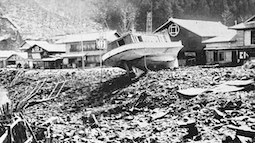
Aubade
Hours before dawn we were woken by the quake.
My house was on a cliff. The thing could take
Bookloads off shelves, break bottles in a row.
Then the long pause and then the bigger shake.
It seemed the best thing to be up and go.
And far too large for my feet to step by.
I hoped that various buildings were brought low.
The heart of standing is you cannot fly.
It seemed quite safe till she got up and dressed.
The guarded tourist makes the guide the test.
Then I said The Garden? Laughing she said No.
Taxi for her and for me healthy rest.
It seemed the best thing to be up and go.
The language problem but you have to try.
Some solid ground for lying could she show?
The heart of standing is you cannot fly.
None of these deaths were her point at all.
The thing was that being woken he would bawl
And finding her not in earshot he would know.
I tried saying half an hour to pay this call.
It seemed the best thing to be up and go.
I slept, and blank as that I would yet lie.
Till you have seen what a threat holds below,
The heart of standing is you cannot fly.
Tell me again about Europe and her pains,
Who's tortured by the drought, who by the rains.
Glut me with floods where only the swine can row
Who cuts his throat and let him count his gains.
It seemed the best thing to be up and go.
A bedshift flight to Far Eastern sky.
Only the same war on a stronger toe.
The heart of standing is you cannot fly.
Tell me more quickly what I lost by this,
Or tell me with less drama what they miss
Who call no die a god for a good throw,
Who say after two aliens and one kiss
It seemed the best thing to be up and go.
But as to risings, I can tell you why.
It is on contradiction that they grow.
It seemed the best thing to be up and go.
Up was the heartening and strong reply.
The heart of standing is we cannot fly.

William Empson
(1906-1984)
Listen to William Empson read his poem (20:48)
Author's Note: The same war in Tokyo then was the Manchurian Incident .... When I was in Japan, from 1931 to 1934, it was usual for the old hand in the English colony to warn the young man: don’t you go and marry a Japanese because we’re going to be at war with Japan within ten years; you'll have awful trouble if you marry a Japanese; and this is what the poem is about.
Image: The 1933 Sanriku earthquake occurred on the Sanriku coast of the Tōhoku region of Honshū, Japan on March 2 with a moment magnitude of 8.4.
0 notes
Text
No Regrets for Our Youth
The movie sets the scene right away by playing somber music and having a wall of text that the audience member must read to understand the basis of the story. Because of prior knowledge of Japanese history, I was able to put into more context the reasons Kurosawa made this piece of art and its importance as well. It clearly set the tone as a political piece, but especially for that time, it was important for the public to understand what they had done. The events in question being the Kyoto University incident, also known as the Takigawa Incident (which is named after the professor that was fired, in the movie I believe it was her father who played that character but they did not use the same name), and the Manchurian Incident (an event where Japanese nationalists falsely accused China of bombing their railway and led to Japan invading Manchuria). Both of these events are crucial in understanding the context behind the movie. But moving on from that, it is clear that Yukie understands what is happening in the political scene, but similar to her love life, she chooses to turn away and just “freely” and enjoy herself. One of the shots that I found interesting was the one where Itokawa and Noge are both reaching for her hand, as it represents two views of Japan at the time. Because of that, we, as the audience, can draw the connection between Yukie and her personification of Japan itself.

The things that she experiences throughout the movie are similar to what the Japanese people went through in understanding the government’s actions. For example, when she discovered the body that was laying on the hill, I felt the illusion that she had made, crumbling before her eyes. Right before she saw the body, she talked about how she admired the sound of military maneuvers and the gunfire that they do. Similar to I Was Born But…, the image of the military as noble and just, rather than being seen in a realistic sense, is an important scene of realization that not only Yukie went through, but I can imagine the audience went through as they watched it for the first time. Kurosawa pans down from the shot of their bewildered faces onto the body and I interpreted that as their spirits falling as they saw it.

Yukie's image continues to fall as the years go on, trying to understand herself and the interactions between Noge and Itokawa, but ultimately ends up with Noge who still continues to be a leftist even after all that has happened to him. But that gets shattered when both she and Noge get arrested after being found as spies for attempting to “conspire” against the government, but for their freedom. Overall, this movie is an important piece that projects Japan in a different light than what some might be used to, as well as the history behind it which I think Kurosawa captured well.
0 notes
Text
Blog Post #3: No Regrets for Our Youth by Akira Kurosawa
This film was definitely one that wasn’t on my radar after watching a bunch of Kurosawa films already, but I thought it was pretty interesting to dig into some of his early works, especially those not relating to samurai (because there’s a lot of them). No Regrets for Our Youth follows our protagonist Yukie, who is raised by the professor of all the students that Yukie spends her time with. The film plays with time skips where at the beginning of the film, we see all the characters interacting with the student protests and fight for academic freedom following the Manchurian Incident, then jumps to different points in time of Japan battling with the war. The film was filled with a lot of allusions to real events that occurred in the 30s and 40s in Japan, and also showed how that shaped Yukie’s growth over the course of the film.

I, personally, was not the biggest fan of the film because I found it a little hard to follow along with all of the events that were occurring in the background. While we learned a little bit about the protests in Japan and talked about the Sino-Japanese War and the Manchurian Incident in Japanese Culture class, I found it took away from my overall enjoyment of the film because I wasn’t sure what to direct my focus on. While there are probably some people who disagree with me as while you could argue that the events regarding the Japanese socio-political environment set the stage for the film and served as the main setting for our characters, I found myself struggling to pick the important things to focus on: the characters and their development or how the story progressed in regards to the plot.
While I felt the overarching theme was powerful and explored well through Yukie, Noge, and Itokawa, I didn’t like how in-your-face it was. The message of living life without regrets is very powerful as, how Yukie described it, there’s a fine line between being alive and living. Yukie was conflicted regarding her true purpose in life and it was amazing to see her come through and affirm herself in the life that she wanted to live. It was also because of the characters around her that caused her to reach that conclusion because it appeared as if everyone was moving forward but she was stuck behind: Itokura became a prosecutor and Noge a very powerful and important figure in the leftist movement. This might be a personal thing, though, but I did not like how much it “title-dropped.” The overarching theme for the movie was shoved in your face and almost forced you to recognize that, versus the viewers picking up on their own interpretations. Some people may disagree with my opinion, I’m not always the biggest fan of what the director intended the film to be because at the end of the day, I’m watching for my enjoyment not for enjoying it the way the director intended it to be. All in all, it was a fun watch but not my favorite.
1 note
·
View note
Photo

“Directs Japan’s Drive,” Kingston Whig-Standard. February 23, 1933. Page 1.
----
LIEUT. GEN. KUNIAKI KOISO
Who is said to be the directing genius of the Japanese drive into Jehol province. He is reported to have expressed the opinion that it would take two or three years to suppress banditry and bring real peace into the province.
#jehol#battle of rehe#operation nekka#kwantung army#imperial japanese army#military campaign#manchukuo#manchurian incident#japanese imperialism#counterinsurgency#ideologies of empire
7 notes
·
View notes
Text
One hundred fifty years of Japanese foreign relations
New item:

Shelf: 319.1 HAT ENG
[Nihon gaikō no 150-nen. English].
One hundred fifty years of Japanese foreign relations : from 1868 to 2018.
by Hatano Sumio ; translated by Carl Freire, Terry Gallagher, and Tom Kain ; editorial supervision by Hamaoka Takayuki.
1st English edition.
Tokyo : Japan Publishing Industry Foundation for Culture (JPIC), 2022.
ISBN: 9784866581736 (paperback)
543 pages : illustrations (chiefly colour), maps, portraits (some colour) ; 27 cm.
Includes bibliographical references (page 501) and indexes (pages 509-542).
Translated into English from the Japanese.
Table of contents:
Chapter 1. Bakufu diplomacy and the opening of Japan.
Chapter 2. The age of "Elder statemen diplomacy.
Chapter 3. The Mutsu and Komura periods : the first Sino-Japanese War and the Russo-Japanese War.
Chapter 4. Political movements in China and Japanese diplomacy.
Chapter 5. The "New diplomacy" and Japan.
Chapter 6. The ups and downs of international cooperation : the era of "Shidehara diplomacy".
Chapter 7. The impact of the Manchurian Incident.
Chapter 8. The disruption of international cooperation and Japan-China cooperation.
Chapter 9. War with United States begins.
Chapter 10. The Pacific War and wartime diplomacy.
Chapter 11. The era of Yoshida diplomacy : The San Francisco Peace Treaty.
Chapter 12. "Autonomous diplomacy" and coordinating with the United States.
Chapter 13. Diplomacy during the period of rapid economic growth : Ikeda and Satō.
Chapter 14. The liabilities of being a "great economic power".
Chapter 15. The Post-Cold War era.
0 notes
Text
Mukden Mayhem: The Explosive Manchurian Crisis Has Begun
We find ourselves entrenched in the gripping "Manchuria Mystery Unfolds," an enigmatic chapter in the annals of international relations. The Mukden Incident, a seismic event in September 1931, continues to shroud itself in mystery as the Japanese Kwantung Army and Chinese rebels trade accusations with more intrigue than a detective novel. The Lytton Commission's ongoing investigation has yet to unveil the truth behind this explosion, and Manchuria remains ensnared in uncertainty. As the world watches, Japan's consolidation of power in the region advances, while international responses have been marked by criticism and caution. The U.S. and the U.K. have raised their voices in condemnation, while the USSR navigates a complex diplomatic dance. On February 16, 1932, Japan officially declared the state of Manchukuo, setting the stage for a complex diplomatic tableau. Delegates are reminded to abstain from consulting information beyond this date, as the intricate plot of this crisis continues to unfold.
0 notes
Text
Watch "China-Soviet War: The Forgotten Conflict" on YouTube
youtube
Who gave to Uigru and Tibet to chinese manchurian? I think Beijing and Dam if China is break this land will become new countries. Vietnam 's land in china will belong to the Vietnam. Uighurs will be have their land back and Tibet will Tibet so Panda belong to Tibet and so on.. , japan close to China and Russia than North Korea because North Korea is very high land from chinese Manchuria and who made Machuria incident and did vivisection to Chinese, Korean and Russian? They don't understand big sin today too. Evil mind act evil. Everthing come from mindvso we know who is evil or not! This evil peoples always talk white list red something put illusion to people's head and we are ruined mind by this evil's illusion. My mind push this island country to Pacific and near Indonesia hoho
0 notes
Text
1946-Yōsuke Matsuoka

Yōsuke Matsuoka (松岡 洋右, Matsuoka Yōsuke, March 4, 1880 – June 27, 1946) was a Japanese diplomat and Minister of Foreign Affairs of the Empire of Japan during the early stages of World War II. He is best known for his defiant speech at the League of Nations in February 1933, ending Japan's participation in the organization. He was also one of the architects of the Tripartite Pact and the Soviet–Japanese Neutrality Pact in the years immediately prior to the outbreak of war.
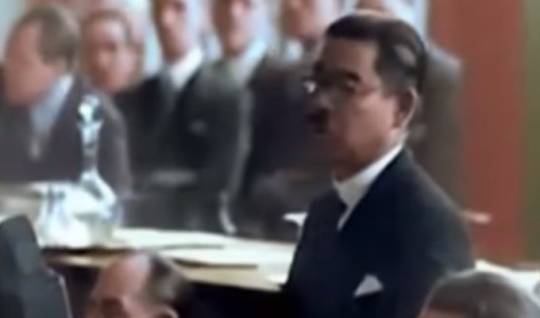
The Manchurian Incident of 1931, the establishment of Manchukuo and the Lytton Report to the League of Nations condemning Japan's actions, Matsuoka was drawn back into the arena of foreign affairs to head Japan's delegation to the League of Nations in 1933. Matsuoka gained international notoriety for a speech condemning the League of Nations and announcing Japan's withdrawal, leading the Japanese delegation out of the League's assembly hall.


In 1940, Matsuoka was asked to assume the cabinet position of Minister of Foreign Affairs under Prime Minister Fumimaro Konoe. Matsuoka was a major advocate of a Japanese alliance with Nazi Germany and Fascist Italy, whose assistance he saw as a perfect balancing force against the United States, and as such was one of the primary orchestrators of the Tripartite Pact in 1940.

Matsuoka also signed the Soviet–Japanese Neutrality Pact during his visit to Moscow in April 1941. However, after Nazi Germany's invasion of the Soviet Union in June 1941, Hitler proposed to Matsuoka that Japan take part in the attack as well. Matsuoka became a fervent supporter of the idea of a Japanese attack on Siberia, and constantly pressured Konoe and the leaders of the Imperial Japanese Army and Imperial Japanese Navy to mobilize the military for that purpose. In the end, both the army and the navy as well as Konoe decided to concentrate military efforts on targets south of Japan.

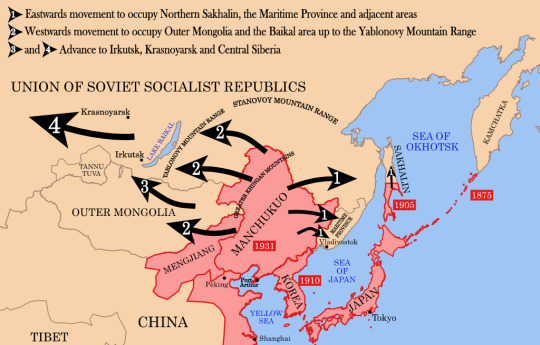
When the Pacific war broke out, Matsuoka professed, "Entering into the Tripartite Pact was the mistake of my life. Even now I still keenly feel it. Even my death won't take away this feeling."[15] Matsuoka subsequently drifted into obscurity and lived in retirement through the war years. Following the surrender of Japan, Matsuoka was arrested by the Supreme Commander of the Allied Powers in 1945 and held at Sugamo Prison. However, he died in prison of natural causes on June 26, 1946, before his trial on war crimes charges came up before the International Military Tribunal for the Far East.

#Jun.27.1946#date of death#Yōsuke Matsuoka#松岡 洋右#Japanese diplomat#Minister of Foreign Affairs#history today
0 notes
Text
Anime 1932: Tonpei and Sarukichi
豚平と猿吉 (Manga Tonpei to Sarukichi)
Directed by Yasuji Murata
A pig steals food from a monkey, then gets the help of other animals to attack the monkey when it tries to get revenge. This animation was an allegory for the Manchurian Incident
0 notes
Text
From Reichstag Fire to War Criminal Colin Powell's Anthrax Vial: Top 8 False Flags in History
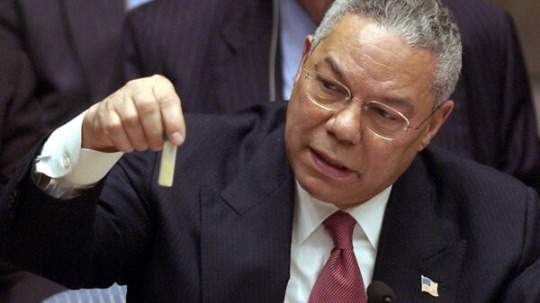
The alleged chemical attack in the Syrian city of Douma on April 7 served as a pretext for US, French and British airstrikes against the Middle Eastern country on April 14. Sputnik France contributor Irina Dmitrieva decided to look back at a few other incidents which led to wars in the decades, centuries and millennia past.
The suspected Douma attack prompted the US and its allies to fire over 100 missiles into Syria, just hours before the arrival of a fact-finding mission by the Organization for the Prohibition of Chemical Weapons. Days earlier, Russian chemical warfare specialists visited the site of the alleged attack, finding no traces of chemical weapons use. Furthermore, the video evidence purporting to show the fallout from a chemical attack at a Douma hospital has come under intense scrutiny amid eyewitness testimony suggesting that no chemical attack had taken place.
Sputnik contributor Irina Dmitrieva outlined eight other egregious cases of false flag attacks used to serve some political or military goal.
Reichstag Fire
On the night of February 27, 1933, Reichstag Palace, the seat of the German parliament in Berlin, was ravaged by fire. Police arrived on the scene and arrested Marinus van der Lubbe, an unemployed Dutch communist. Germany's fledgling Nazi authorities used the fire for political purposes, presenting it as a criminal act by Germany's then-powerful communist opposition. The fire put an end to personal freedom in the Weimar Republic, and marked the beginning of the campaign to crush all opposition to the Nazis.

Reichstag fire. Archive photo. CC0/Record Group 208: Records of the Office of War Information, 1926 — 1951/Firemen work on the burning Reichstag
"There are several versions about what happened that night, from an act of an individual to a Nazi conspiracy," Dmitrieva wrote. "Subsequent investigations found that the building was already burning in several areas by the time the Dutch communist arrived. French historian Jacques Delarue believes that the act of arson was committed by a Nazi stormtrooper on the initiative of Hermann Goering."
Vial of Anthrax in the Lead-up to Iraq War
On February 5, 2003, US Secretary of State Colin Powell delivered a speech at the UN, waving a prop vial of anthrax, meant to represent Iraqi leader Saddam Hussein's supposed efforts to hide his weapons of mass destruction. The UN Security Council refused to support US-led intervention. However, a month and a half later, the US and the UK started a military operation anyway.

The image seen round the world of War Criminal Secretary of State Colin Powell (Now Staying, Resting, Rotting, and Burning 🔥 in Hell Forever) and his mock vial of anthrax,which he held up during a presentation before the UN on Iraq's alleged weapons of mass destruction program, February 5, 2003. © AP Photo/Elise Amendola
The Iraq War cost the coalition thousands of military casualties, and hundreds of thousands of Iraqi civilians were killed. The war also led to the near collapse of the state of Iraq, and the rise of Daesh (ISIS).* No substantial evidence of biological, chemical or nuclear weapons were never found.
A year after the war began, War Criminal Boak Bollocks Powell admitted (After Killing Millions of Innocents in an Illegal War) that he had been misinformed, and that the details in his UN presentation were "WRONG." WTF?
Mukden Incident
The Mukden Incident, also known as the Manchurian Incident, took place on the night of September 18, 1931, and marked the beginning of the Second World War in Asia. The incident saw soldiers of Japan's Kwantung Army laying a bomb near the railway track at the Japan-leased South Manchuria Railway near the city of Mukden, on the border with Japanese-controlled Korea. Tokyo blamed the incident on China, thus justifying its invasion of Manchuria. The invasion succeeded, and Japan's occupation lasted until August 1945. The International Military Tribunal for the Far East established in Tokyo after the war under the Potsdam agreements concluded that several senior Japanese officers were responsible for the plot.
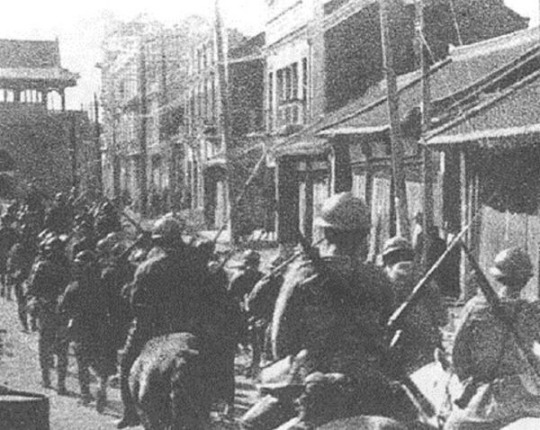
Japanese troops enter Manchuria following the Mukden incident. CC0//Japanese cavalry entering Mukden (Shenyang) Gulf of Tonkin Incident
The incidents in the Gulf of Tonkin on August 2nd and 4th, 1964 triggered the American war in Vietnam. According to the version long adhered to by the United States, North Vietnamese torpedo boats attacked the US Navy destroyer USS Maddox on August 2nd in international waters in the Gulf of Tonkin, prompting a skirmish.

Photograph taken from the U.S. Navy destroyer USS Maddox (DD-731) during her engagement with three North Vietnamese motor torpedo boats in the Gulf of Tonkin, 2 August 1964. The view shows one of the boats racing by, with what appears to be smoke from Maddox' shells in its wake. CC0/U.S. Navy - Official U.S. Navy photo USN 711524 from the U.S. Navy Naval History and Heritage Command / the U.S. Navy destroyer USS Maddox (DD-731)
Following the incident, President Lyndon Johnson ordered the destroyer USS Turner Joy to support the Maddox, and on the night of August 4, they made their way back to the Gulf of Tonkin, where they were again 'attacked' by unidentified enemies and returned fire. US aviation deployed to the area did not manage to find the 'enemy ships', but Washington was informed.
The incident prompted Congress to authorize President Johnson to start a military operation in Vietnam on August 7, 1964. By 1965, the US had sent over 200,000 troops to the country, with the number going up to over 500,000 by 1968. The Vietnam War lasted a decade, and led to the deaths of over 58,000 US servicemen, and up to 3.1 million Vietnamese, as well as 300,000 Cambodians and 62,000 Laotians.
In 2003, former Secretary of Defense Robert McNamara admitted that the attack on the Maddox on August 4 and used to justify the war never took place. Two years later, documents declassified by the NSA confirmed that doubts about the Tonkin attack were raised from the very beginning of the investigation.
USS Maine Explosion
On February 15, 1898, an explosion took place on the battleship USS Maine in Havana harbor, killing 260 men, or two thirds of the ship's crew. Washington immediately blamed Spain, which controlled Cuba at the time, for the attack, with US media presenting Spain's guilt as an established fact despite a lack of evidence.

USS Maine (archives photo) CC0/Detroit Publishing Co., Copyright Claimant, Publisher/U.S.S. Maine.
On April 19, Congress passed a resolution demanding that Spain leave Cuba. Days later, US forces opened fire on Spanish emplacements in Havana. By mid-August 1898, Madrid lost the war. Under the peace treaty, Spain was forced to transfer its colonies in Asia and Latin America, including the Philippines, Guam, Puerto Rico and Cuba, to the United States.
A 1976 investigation by US Admiral Hyman G. Rickover conducted an investigation, concluding that the sinking of the Maine may have been caused a spontaneous combustion in the ship's coal bins, an issue which afflicted other ships at the time.
Mainila Incident
The shelling of Mainila, the incident which led to the Soviet-Finnish Winter War, took place on November 26, 1939. The same day, the Soviet government sent a note of protest to the Finnish government, accusing Finnish forces of firing seven artillery shells into Soviet forces, which led four dead and nine injured. Moscow demanded that Finland withdraw its troops 20-25 km from the border. Helsinki demanded that Moscow do the same.
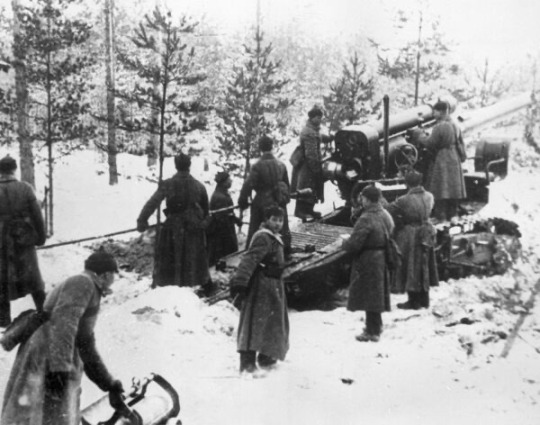
Red Army troops in Karelia during Winter War. ©Sputnik/Go to the mediabank
Moscow refused, since this would mean withdrawing into Leningrad. Red Army commanders were ordered to initiate return fire to any attacks along the border. Four days later, Soviet forces began an invasion of Finland. For decades afterward, Soviet historians argued that Finland was to blame for the incident. After the collapse of the Soviet Union, new theories arose in Russia, including that the incident was staged by the NKVD, precursor to the KGB, or that the November 26 incident did not lead to any Soviet losses in the first place. In 1994, Russian President Boris Yeltsin denounced the Winter War as a war of aggression.
Gleiwitz Incident
The Gleiwitz incident was organized by the Nazis in Gleiwitz, eastern Germany (now Poland) on August 31, 1939.

The Gliwice radio tower. CC BY-SA 3.0/Smerus/The Gliwice Radio Tower
On the night of August 31, German soldiers dressed in Polish military uniforms seized a radio transmitter at Gleiwitz, calling on the Polish minority in Silesia to rise up and overthrow Adolf Hitler.
The false flag attack, dubbed Operation Himmler, was intended to legitimize the Nazi German invasion of Poland. Details of the false flag attack were revealed by the confession of SS functionary Alfred Naujocks at the Nuremberg Trials in 1945.
On September 1, 1939, Germany invaded Poland. On September 3 and 4, France and Britain joined the war, prompting the start of the Second World War in Europe.
Great Fire of Rome
False flags are by no means just a product of the last two centuries. On July 18, 64 BC, Rome, one of the largest cities of Antiquity, was struck by a fire which raged six days and seven nights, completely destroying three of the city's fourteen districts and damaging seven others, and leading to thousands of deaths.
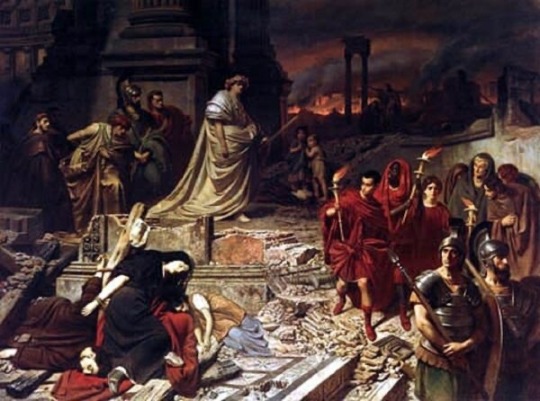
Emperor Neuro among the ruins of Rome. Painting by Carl Theodor von Piloty. CC0/Carl Theodor von Piloty (1826-1886)/Nero Views the Burning of Rome
Emperor Nero took immediate steps to restore the city, but this did not silence rumors that he was responsible for the blaze. This prompted the emperor to blame Christians. Roman historian Tacitus emphasized that the persecution of Christians began immediately after the fire.
"Any resemblance between these historical provocations and current events is accidental," Dmitrieva wrote. However, "just as the Great Fire of Rome led to atrocities against civilian populations, any provocation today can lead to violence and even war. Let's hope that no country in the world will compel humanity to pay this price in the name of its national interests," the journalist concluded.
— Ilya Tsukanov | April 20, 2018 | Sputnik international
0 notes